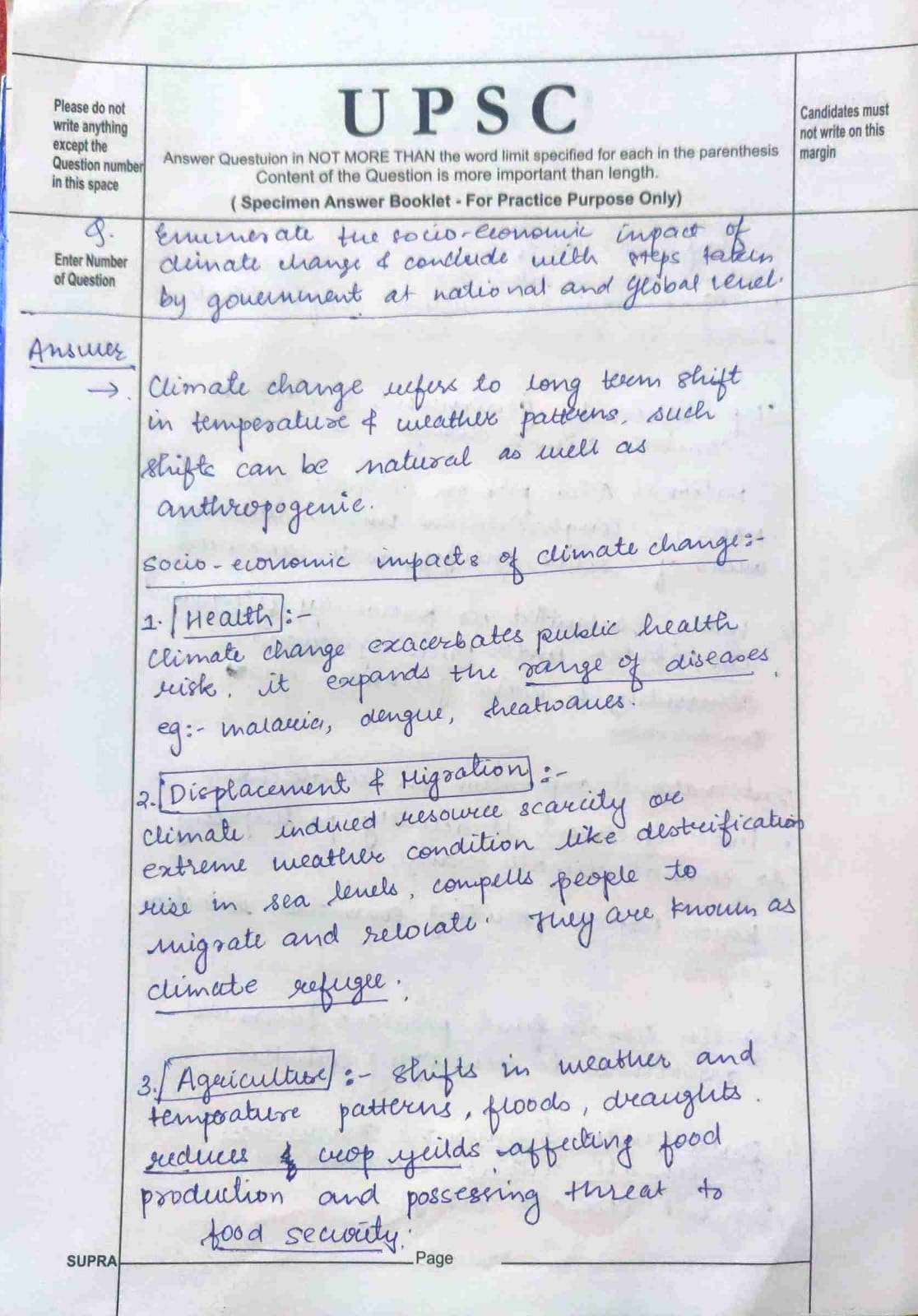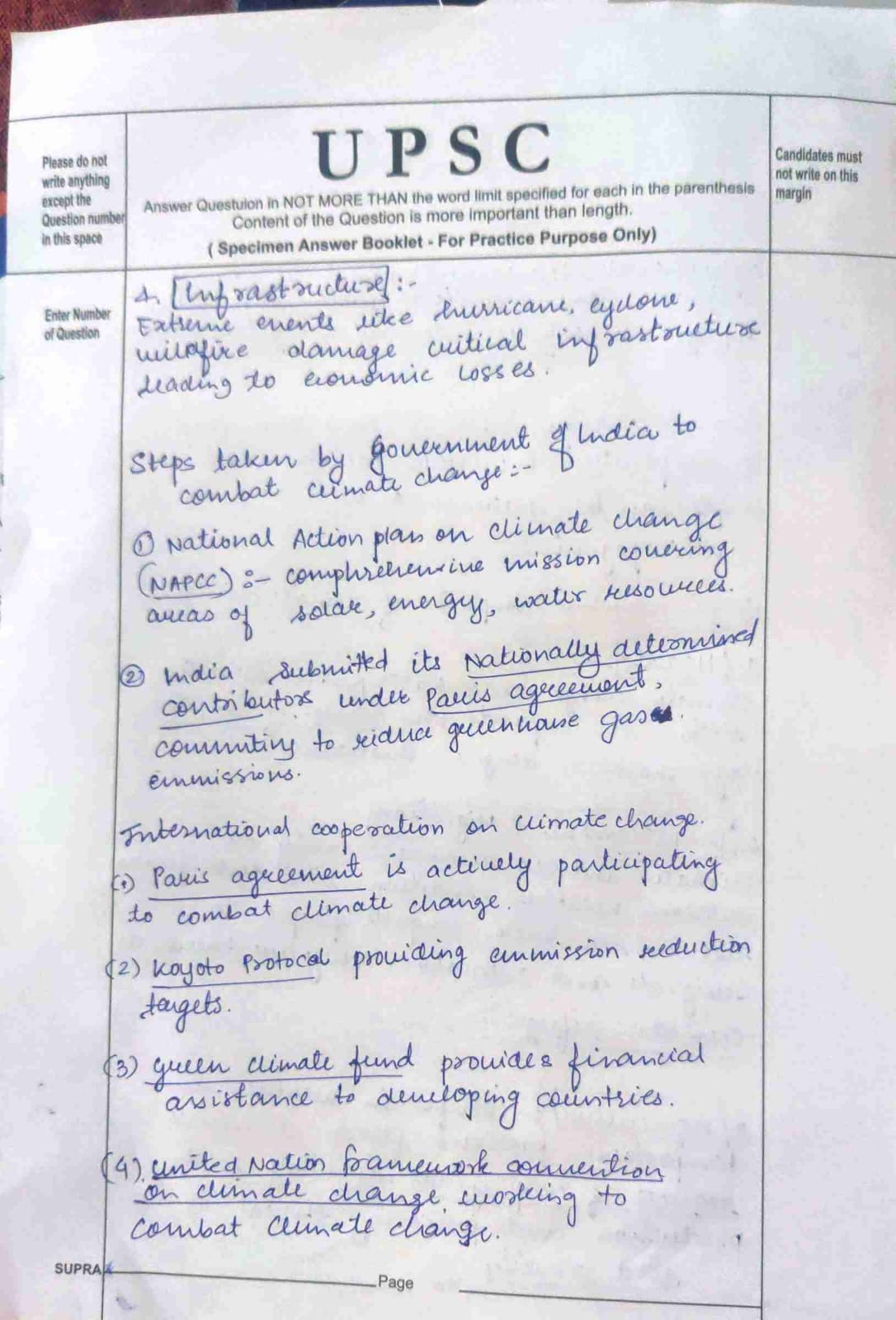Home/Biodiversity & Environment/Climate Change/Page 2
Climate Change
Share
501 Followers
543 Answers
280 Questions
Resources & Suggestions
Mains Answer Writing Latest Articles
On: April 18, 2025
Daily Answer Writing Practice Questions (18 April 2025)
Do you agree with the claim that indecision and risk aversion are prevalent issues in Indian bureaucracy? Support your answer with logical reasoning. (150 words) ऐसा कहा जाता है कि भारतीय नौकरशाही में अनिर्णय और जोखिम से बचने की प्रवृत्ति ...
On: April 18, 2025
Comments:
0
Strengthening India’s Cyber Defence
Rising Threats Digital Era Challenges: 2024 marks a significant rise in digital threats, particularly from AI and cyberattacks. Key Issues: Disinformation campaigns. Cyber fraud affecting daily life. Current Major Cyber Threats Ransomware Rampage: Over 48,000 instances of WannaCry ransomware detected ...
On: April 18, 2025
Comments:
0
भारत की साइबर सुरक्षा
बढ़ते खतरे कृत्रिम बुद्धिमत्ता (AI) और साइबर हमले: 2024 में AI और साइबर हमलों के खतरे में वृद्धि। महत्वपूर्ण अवसंरचना पर हमले: डिजिटल हमलों और दुष्प्रचार अभियानों की संभावना बढ़ी है। प्रमुख साइबर खतरें रैनसमवेयर का प्रकोप: 48,000 से अधिक ...

How does climate change affect global weather patterns and extreme weather events?
Weather systems all around the world are modified by climate change and the number of associated events of extreme weather increases. Global warming changes the circulation of the atmosphere and oceans, which impacts, among other things, the amount of rain or snow that falls on the Earth, the speedRead more
Weather systems all around the world are modified by climate change and the number of associated events of extreme weather increases. Global warming changes the circulation of the atmosphere and oceans, which impacts, among other things, the amount of rain or snow that falls on the Earth, the speed of winds, and the power of storms.
As the oceans warm up, hurricanes and typhoons get worse and because there is lots of water vapor in the air heavy rainfall results in severe flooding. Heatwaves are occurring more often and are more intense posing risks to both people and crops. The instances of Drought and wildfires are on the rise with an increase in temperature and a decrease in rain.
Every occurrence of this nature translates to significant financial losses, population relocation, and environmental degradation. Combating climate change its consequences and finding means of coping with it is the strategy for a sustainable development.
See lesscampaigns about climate change
As we move to the next stage of change, advocacy, especially education and public awareness within grassroots actions, takes a primary role in the pronounced action on climate change. It can be done through climate change at schools and school teacher training. Such campaigns in the format for all cRead more
As we move to the next stage of change, advocacy, especially education and public awareness within grassroots actions, takes a primary role in the pronounced action on climate change. It can be done through climate change at schools and school teacher training.
Such campaigns in the format for all categories of the audience, for instance. Social media, TV, radio, and print can effectively cater to a vast portion of the society in proportions to their availability. Contributing towards this, there are communicative and participatory events like workshops and seminars. There is also the strengthening of their conduits in creating change through specific projects that involve the general public for instance, citizen science projects. For instance, climate espousing beliefs and the people’s voice can also take action against the authorities and make them make certain decisions.
International programs and cross-national education shall also enhance the upsurge in grass root efforts encouraging the world to be more synergetic, where with the taking of initiatives aimed at educating or raising awareness, also empowerment through the communicating the need to act, broadens the scope of action change within the said levels.
See lessPolar Meltdown: Unraveling the Impact of Ice Cap Melting on Earth’s Magnetic Field and Weather Patterns
The melting of the polar ice caps has direct effects on global weather patterns. 1. Disrupted Ocean Currents: The freezing and thawing cycles of water contribute to the rise and decline of temperatures in the earth’s oceans which in turn may destroy some of the ocean currents including the Gulf streRead more
The melting of the polar ice caps has direct effects on global weather patterns.
1. Disrupted Ocean Currents: The freezing and thawing cycles of water contribute to the rise and decline of temperatures in the earth’s oceans which in turn may destroy some of the ocean currents including the Gulf stream. Ocean currents help to circulate air around the globe and prevent certain regions from becoming extremely hot or cold causing a change in climate disruption such as extreme heat waves, or major flooding.
2. Sea Level Rise: The Greenland and Antarctic ice sheets contain vast amounts of fresh water that melted could cause the sea level to rise which in turn causes coastal areas to erode and inundate without considering the impact on the economy in those regions. Furthermore, this would lead to a change in behavioral tendencies of people within those regions and exacerbate extreme normal occurrences.
3. Altered Circulation in the Atmosphere: The effect of ice thawing is felt on the pressure and temperature of the atmosphere, which then interrupts the normal flow of the wind including the jet streams. In most cases this kind of circulation causes many storms, which are also stronger than usual and occur more frequently.
See lessTo sum it up, no matter how tenuous the links between the melting of polar ice and the earth’s magnetic field, the secondary repercussions on global weathering are quite elementary. Polar ice melt, as it seems, is a very intricate concern dealing with a lot of factors that govern the composition and the behaviour of climate and ecosystems across the globe.
Why Indian Railyway is still running Diesel locomotive, rather than knowing the scarcity of fossil fuel ?
Despite the global shift toward clean energy sources, including in the rail transport sector, India is still expanding and continuing to build diesel electric locomotives. This is due to the following factors: 1. Constraints of Infrastructure: Restructuring the rail tracks for the purpose of electriRead more
Despite the global shift toward clean energy sources, including in the rail transport sector, India is still expanding and continuing to build diesel electric locomotives. This is due to the following factors:
1. Constraints of Infrastructure:
Restructuring the rail tracks for the purpose of electrifying them is highly investment and time intensive. There is a considerable network of railway lines in India and especially in regions that are difficult and mountainous.
2. Economical Inducements:
Diesel engines are adaptable and efficient and can easily operate on non-electrified lines without power.
The costs involved in acquiring diesel engines and their servicing and repairs are lower than those of electric engines both in the initial costs and over the life of the systems.
3. Technological Limitations:
Electric locomotives are effective, however there is a need for a continuous power supply. Power shortage and power grid problems may affect their efficiency.
4. Indigenous Technology:
The country has established a home-grown technology which manufactures diesel locomotives in order to minimize the level of imports.
5. Gradual Transition:
In India, starting with electric locos, there is a very slow expansion.
Utilization of both diesel and electric locomotive makes it conducive to transition.
Even if diesel locomotives have a few advantages, the use of petroleum cannot be overlooked, hence India has to move ahead with electric locomotive enhancement and with other fuels such as hydrogen and bio-fuels.
See lessWhat is the biggest kind of pollution in India?
India's biggest pollution problem is air pollution, specifically particulate matter (PM) pollution. This type of pollution is responsible for over 1.1 million premature deaths in India, with 56% of those deaths attributed to outdoor PM 2.5 concentration and 44% to household air pollution . *Major SoRead more
India’s biggest pollution problem is air pollution, specifically particulate matter (PM) pollution. This type of pollution is responsible for over 1.1 million premature deaths in India, with 56% of those deaths attributed to outdoor PM 2.5 concentration and 44% to household air pollution .
*Major Sources of Air Pollution:*
– _Industrial Pollution_: Accounts for 51% of air pollution in India, primarily due to the burning of fossil fuels and chemicals .
– _Vehicular Emissions_: Contributes 27% to air pollution, mainly from cars, trucks, and other vehicles .
– _Crop Burning_: Responsible for 17% of air pollution, particularly during agricultural seasons .
– _Biomass Burning_: A significant source of indoor air pollution, especially in rural areas where fuelwood and biomass are used for cooking and heating .
*Health Impacts:*
Air pollution in India is linked to various health issues, including respiratory problems, cardiovascular diseases, and even cognitive impairments .The World Health Organization (WHO) reports that one out of nine deaths in India is attributed to air pollution .
*Government Initiatives:*
See lessTo combat air pollution, the Indian government has launched several initiatives, such as the National Clean Air Programme (NCAP), which aims to reduce PM 2.5 and PM 10 concentrations by 20-30% by 2024 . Additionally, measures like the Odd-Even Rule in Delhi and promoting cleaner fuels like LPG and CNG are being implemented.
Climate change
Satellite-based climate monitoring systems have revolutionized our ability to manage and mitigate climate risks by providing continuous, real-time data on various environmental factors such as temperature, rainfall, ocean currents, and greenhouse gas emissions. These systems enable early detection oRead more
Satellite-based climate monitoring systems have revolutionized our ability to manage and mitigate climate risks by providing continuous, real-time data on various environmental factors such as temperature, rainfall, ocean currents, and greenhouse gas emissions. These systems enable early detection of natural disasters, track extreme weather events, and provide critical insights for climate change modeling and policy-making. For example, India’s RISAT-1 and the European Union’s Copernicus satellite system play essential roles in monitoring deforestation, glacier melt, and ocean health, supporting both local and global climate initiatives.
The advantages of satellite-based systems lie in their broad coverage and consistency. Satellites can observe remote and vast areas, providing invaluable data for regions where ground-based monitoring is difficult. This data enhances disaster preparedness and supports sustainable development efforts by informing agricultural planning, water management, and urban resilience strategies.
However, these systems also have limitations. Satellites are costly to develop and launch, and their high dependence on advanced technology makes them susceptible to technical malfunctions. Additionally, data interpretation requires expertise, which can be a barrier for developing nations. Despite these challenges, satellite monitoring remains a powerful tool for climate action, especially when complemented by ground data and international cooperation to ensure accuracy and accessibility.
See lessEnumerate the Socio-economic impact of climate change and Conclude with steps taken by government at national and global level.
*Socio-Economic Impacts of Climate Change:* 1. Health: Increased disease spread, heat stress, and mental health issues. 2. Food Security: Crop failures, water scarcity, and changed weather patterns. 3. Economic Growth: Losses in agriculture, infrastructure, and tourism. 4. Human Migration: DisplacemRead more
*Socio-Economic Impacts of Climate Change:*
1. Health: Increased disease spread, heat stress, and mental health issues.
2. Food Security: Crop failures, water scarcity, and changed weather patterns.
3. Economic Growth: Losses in agriculture, infrastructure, and tourism.
4. Human Migration: Displacement due to sea-level rise, droughts, and floods.
5. Social Inequality: Unequal distribution of climate impacts and resources.
6. Water Scarcity: Changes in precipitation patterns and increased evaporation.
7. Energy Security: Impacts on renewable energy sources and grid resilience.
8. Cultural Heritage: Loss of traditional livelihoods and cultural identity.
*National Level Initiatives (India):*
1. National Action Plan on Climate Change (NAPCC)
2. National Clean Energy and Environment Fund (NCEEF)
3. Renewable Energy Targets (175 GW by 2022)
4. Electric Vehicle Policy
5. Green India Mission
*Global Level Initiatives:*
1. Paris Agreement (2015)
2. United Nations Framework Convention on Climate Change (UNFCCC)
3. Sustainable Development Goals (SDGs)
4. Intergovernmental Panel on Climate Change (IPCC)
5. Climate and Clean Air Coalition (CCAC)
*Key Steps:*
1. Reduce greenhouse gas emissions
2. Promote renewable energy
3. Enhance energy efficiency
4. Protect and restore natural ecosystems
5. Support climate-resilient infrastructure
6. Encourage sustainable agriculture practices
7. Foster international cooperation and climate governance
*Way Forward:*
1. Implement policies and regulations
2. Increase public awareness and education
3. Encourage private sector investment
4. Develop climate-resilient technologies
5. Strengthen global partnerships and cooperation.
Mitigating climate change requires collective action, and governments, businesses, and individuals must work together to address this global challenge.
See lessWhat are the most effective strategies to reduce greenhouse gas emissions and mitigate the impacts of climate change?
Greenhouse gas emissions (GHGs) are gases released into the atmosphere, trapping heat and contributing to global warming and climate change.example- carbon dioxide, methane etc. India's greenhouse gas emissions total 3.3 billion tons ( ranking 5th globally ) i.e.Energy (60%), Industry (21%), AgriculRead more
Greenhouse gas emissions (GHGs) are gases released into the atmosphere, trapping heat and contributing to global warming and climate change.example- carbon dioxide, methane etc.
India’s greenhouse gas emissions total 3.3 billion tons ( ranking 5th globally ) i.e.Energy (60%), Industry (21%), Agriculture (14%) and Waste (5%). India aims to reduce emissions by 33 to 35% by 2030.
Effective strategies to reduce Greenhouse gas emissions and it’s impact on climate change –
Reducing greenhouse gases requires collective action through renewable energy, energy efficiency, sustainable practices and conservation. Together we can mitigate climate change, protect the planet and ensure a healthier future.
See lessEnumerate the Socio-economic impact of climate change and Conclude with steps taken by government at national and global level.



See lessWhat is the most efficient way to reduce climate change
Today climate change is the most important issue the globe is facing which needs to be discussed at the earliest.There are several ways by which we can overcome climate change:- 1.limitising the carbon emission by controlling vehicular and industrial pollution. 2.Proper urbanisation facility and poRead more
Today climate change is the most important issue the globe is facing which needs to be discussed at the earliest.There are several ways by which we can overcome climate change:-
1.limitising the carbon emission by controlling vehicular and industrial pollution.
2.Proper urbanisation facility and population control methods.
3.Avoiding the use of hybrid food materials 4. Selection of proper area for waste disposal.
5.Afforestation.
6.Use of less electricity and electronics components.
These are the various ways by which we can overcome climate change.
See less